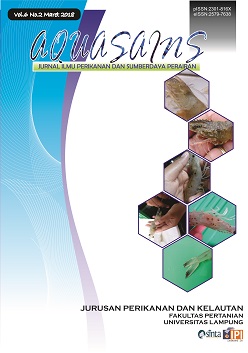SPESIES COMPOSITION AND DENSITY OF MACROALGAE IN KAMBOWA VILAGE WATERS, SOUTHEAST SULAWESI
DOI:
https://doi.org/10.23960/aqs.v6i2.p605-610 Abstract View: 490
Abstract View: 490
Abstract
Macroalgae has an important role in marine waters both ecologically and economically. This study aims to provide information about spesies composition and density of macoalgae in the kambowa village waters and the wealth of macroalgae in south east Sulawesi. The study was conducted in the waters of Kambowa village, north buton district South East Sulawesi from November 2015-January 2016. Sampling of macroalgae were done using quadrate transect (1 x 1 m) and other is 10 m distance and 100 m length. The result of study found that the number of macroalgae spesies consisted of 16 spesies consisting of 7 orders, 10 families, 13 genera. The spesies composition was dominated by Chlorophyta class (43%), Phaeophyta class (37%) and Rhodophyta class (21%). Total density of macroalgae is 542 ind/m2 with 229 ind/m2 by Chlorophyta class, and Phaeophyta and Rhodophyta class that is 201 ind/m2 dan 112 ind/m2. The highest density was 144 ind/m2 with Halimeda macroloba. The lowest density was 2 ind/m2 with Gracillaria edulis.Downloads
Download data is not yet available.
Downloads
Published
2018-03-22
How to Cite
Ira, I. (2018). SPESIES COMPOSITION AND DENSITY OF MACROALGAE IN KAMBOWA VILAGE WATERS, SOUTHEAST SULAWESI. Aqusains: Jurnal Ilmu Perikanan Dan Sumberdaya Perairan, 6(2), 605–610. https://doi.org/10.23960/aqs.v6i2.p605-610
Issue
Section
Articles

.png)










